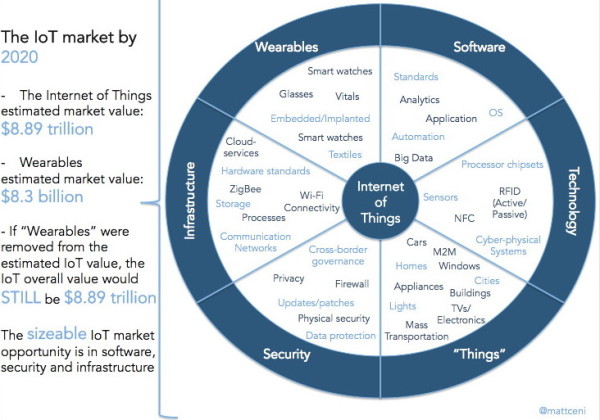The Internet of Things is more than just Glasses, smartphones and smartwatches. It’s more than just smart cars and cities and other “things” that are connected or understood by today’s usage models.
By 2020, it is predicted that the entire Internet of Things will have a market value of $8.89 trillion. There are many factors that enable this value to be reached. There is revenue from the sale of Wearables and “things”, there is software licensing, hardware, and the reduction of operating costs in manufacturing, information technology, research and development, marketing and corporate operations.
Research firm, IDC, expects a globally installed base of IoT will reach around 212 billion things by the end of 2020, including 30.1 billion installed connected autonomous things. Intel predicts there will be 31 billion connected devices. Cisco, a notable leader in IoT research and awareness, predicts 50 billion objects will be connected to the Internet. Gartner predicts these billions of connected “things” add economic value will be $1.9 trillion dollars in 2020.
With this many zeros and connected things being predicted by smart people and forward-thinking companies, it’s enough to make a skeptic out of anyone to think that many computing devices and trillions of dollars of market value will be generated in the next six years. Given the advances in smartphones and tablets and Big Data, could the expected market value be underestimated?
It would be easy, maybe even lazy, for us to think the smartphone will be at the heart of the Internet of Things. With 30.1 billion autonomous things sending and receiving information, and initiating pre-defined manufacturing, marketing or even personal preferences, the smartphone or any other modern device will not be apart of the equation.
In a way, the smartphone is to the Internet of Things, as the beeper is the mobility revolution. The challenge for marketers, communicators and stewards of brands is to understand getting mobile right today is important to establishing best practices and foundational expertise needed to manage an automated future.
It’s important to understand the different segments that will makeup the Internet of Things ecosystem. After reviewing industry research, corporate press releases and blogs and news reports, the following IoT ecosystem framework was built to reconcile the many IoT announcements.
Hopefully, with this ecosystem framework combined with the IoT use-case framework we can start to rationalize what each new development in the emerging technology trend.
